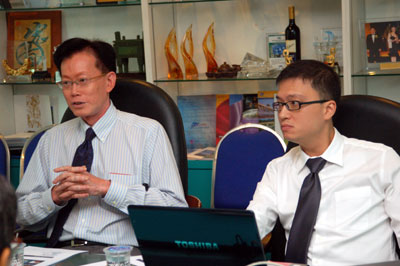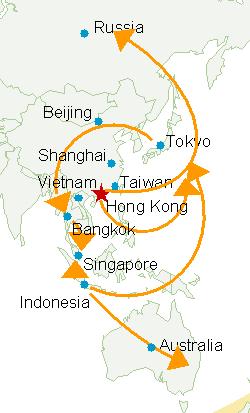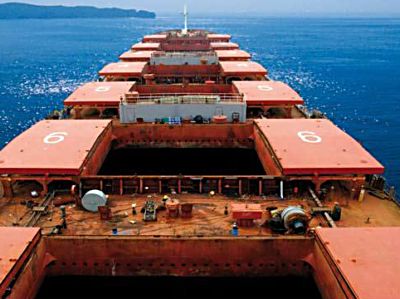
ABOUT 58% of Courage Marine’s revenue last year came from hauling sea sand from neighbouring countries to Singapore for land reclamation works.
Another 30% of the revenue came from transporting coal to China.
This would seem like a boring business but Courage Marine makes a good return on it.
In 2008 and 2009, the company was ranked 10th in the entire shipping world based on its overall performance of these measures: asset turnover, profit margin, return on equity, return on assets, market value of equity and book value of equity.
In 2007, it was No.1.
The ranking of public shipping companies was done by Marine Money International, the only publication in the world that specializes in marine finance information.
Courage Marine, which is listed on the Singapore Exchange, made a presentation to analysts and fund managers yesterday.
 Trade routes of Courage Marine's vessels are concentrated on East Asia, ferrying bulk commodities mainly to China.
Trade routes of Courage Marine's vessels are concentrated on East Asia, ferrying bulk commodities mainly to China.
”The unique aspect of our company and why we give a very good return on investment is our ships are purchased on the second-hand market and are low-capital investments,” said Mr Hsu Chih-Chien, the chairman.
”We know how to manage the fleet, so that even though the average age of our ships is over 20 years, our fleet utilization in many quarters has frequently exceeded 90% in the past 5-6 years.”
Fleet utilization is the proportion of time the fleet is transporting cargo, instead of sitting in a dry dock for maintenance or idling at sea because there is no cargo to move.
”I think our utilisation rates are quite impressive because even though our ships are quite old, their downtime is usually 10% or less,” said Mr Hsu.
The downtime is usually for maintenance, rather than waiting for cargo – except during Q4 of 2008 and the first half of 2009 when world trade almost ground to a halt during the global financial crisis, said Mr Hsu.
Before 2008, there were quarters when Courage Marine achieved as high as 98% utilization rates, added Mr Carl Yuen, the CFO.
Here are some of the highlights from the Q&A session:
Q: What attracts customers to use your old vessels?
Mr Hsu: By far the biggest volume of cargoes carried on bulk carriers worldwide are iron ore and coal. They account for maybe two-thirds of all cargo, and it doesn’t matter if the carriers are two years old or 20 years old. The remainder of the cargoes such as wheat, soyabean and maize – yes, many charterers prefer to use more modern vessels and pay a higher freight rates – but the rates are, just my guess, no more than 10-15% higher.
Q: At what age would you consider scrapping your vessels?
Mr Hsu: There’s no international regulatory age limit but historically, most ships get sent to the demolition yards when they are 25-30 years old. That’s an economic issue because every 5 years, ships have to go through a special survey and they probably have to replace a lot of steel plates, replace a lot of spare parts in the main engine.
Prior to 2003, most ship owners reckoned it’s cheaper to send the ships to demolition yards, use the sale proceeds from the scrapping of the ships and buy a younger vessel. But during the past few years when freight rates were high, ship owners preferred to spend US$1 m, US$1.5 m, US$2 m to repair the ships.

Q: What marketing do you need to do?
Mr Hsu: It’s quite limited. Unlike container ships where to load one ship, you probably need something like 5,000 customers.
For our case, you have one ship, one commodity, one bill of lading, one customer.
For those major commodity importers, in most cases, they know where to find us. You will never see Courage Marine buying advertisement space in the media.
Q: How do you decide on the price to pay for an old ship so you can get a decent return between now and when you scrap the ship?
Mr Hsu: Our basic calculation is for full return on investment within 3 years.
Q: Have you been achieving that ROI in the past?
Mr Hsu: Yes.
Q: For the contracts of affreightment (COA), who bears the risk of fluctuations of the fuel price?
Mr Hsu: The risk is on us.
Our bulk carriers sail rather slowly, at half the speed of containerships. Generally speaking, we don’t have as much pressure to do bunker hedging. If we do time charter, where we rent the ship out, the risk is on the charterer. In COA, we ship the cargo.
Q: Then how do you manage the fuel risk on the COAs?
Mr Hsu: On some contracts, there is a bunker adjustment clause where the freight rate is adjusted if the fuel price moves up or down. If there is no such clause, generally I would ask for a slightly higher rate to cover that risk.
Recent story:
COURAGE MARINE: Buying old ships, working them efficiently





